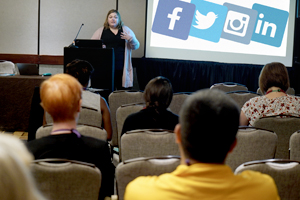
Social media is changing the way we communicate -- not just personally, but professionally as well.
“Now you can share your story with people around the world; you can reach out to anyone,” said Kess Knight, Associate Director of Digital Marketing at AACRAO, during her Monday presentation on the topic at the 2018 AACRAO Technology & Transfer Conference in Minneapolis.
Why social?
Not only can social media broaden your reach beyond your traditional connections, it can also make professional communication and learning faster and easier. It’s:
-
Customizable. Many platforms allow you to segment and personalize your lists and messages, so you can share with targeted audiences.
-
Fast. With emojis, tweets, and texts, you can make your messages short and sweet -- and avoid having them sit unread in an email inbox.
-
Interactive. Online, networking isn’t just for extroverts. You can build connections from your computer -- and deepen them at meetings and conferences to build a stronger community of like-minded individuals.
-
Educational. Social media is an excellent way to find and follow reliable, relevant professional sources and experts; discover perspectives of those you may not otherwise hear (such as first-year students); and learn new and emerging information in quick bites, such as through videos and interactive infographics.
“Recruiters are looking at social profiles,” Knight said. “And as millennials move up, the usage of social media professionally and personally are going to intertwine more than ever -- social may even become a required part of your job. So don’t be afraid of it.”
Choosing a platform
Knight touched on each of the big four social platforms -- Facebook, LinkedIn, Twitter and Instagram.
“You don’t need to master all of them at once,” she suggested. Rather, get familiar with one or two and then branch out from there when you’re comfortable.
Many people use Facebook for friends, family, and to follow news outlets and organizations sharing important information. Facebook groups are also useful for shared-interest conversations. Instagram is photo-driven, so professional development can be done through posting photos of work events with relevant hashtags, so that people who follow higher education topics will find you. LinkedIn is “strictly professional,” Knight says. And Twitter can be both personal and professional, offering niche chats (such as #emchat) and other specific hashtags where you can conveniently engage in conversations, as well as the opportunity to retweet and comment on articles you like as a way to draw attention to your profile and build a professional network.
4-part strategy
Knight laid out four steps for people to take when stretching their professional wings on social:
1. Plan. “How do you want to be known?” Knight asked. “What do you want people to think of when they see or hear your name?”
As you explore the information available on these platforms, consider your personal brand. What areas most interest and excite you? Whom do you admire? What are your professional aspirations? Begin to follow the people and sources that most inspire and educate you.
“Develop a brand persona,” Knight said. “Your identity is about giving value to people and marketing yourself as business professional, which can help you get an interview, establish rapport, and move your career forward through a venue that’s fast, far-reaching, and free.”
Make sure your profile is up-to-date and complete -- including presentations you’ve done and skills you’ve learned, especially on LinkedIn.
“Don’t just copy and paste your resume and job description,” Knight suggested. “Be specific about what makes you unique.”
Once you’ve established your profile, set your goal and persona, and decided who to follow, it’s time for the next steps.
2 & 3. Listen and Engage. Learn from those you follow. Figure out who the thought leaders and top influencers are in your field, and comment, tag, and share/retweet their activity. (Influencers may be bloggers, product reviewers, social media experts, academic researchers, and other trusted source of information.) Pay attentions to the hashtags your heroes use, and follow those. You can also join Facebook or LinkedIn groups relevant to your interests.
“As you start interacting with people in your industry that you’ve heard of or know through someone else, others are likely to respond. If you like an article on LinkedIn, for example, it will pull into your feed and people see your activity,” Knight said. “Your network sees that you’re active and may reach out to talk with you and create a connection.”
Focus on quality over quantity, she cautioned. Find people to follow who are specific to you and your interest.
“People will see who you’re following and understand your vibe and what you’re interested in,” Knight said. “Collaboration builds.”
4. Action. Once you’ve built your social presence, you can start contributing more than tweets and posts.
“A blog or other publication is a great way to build your credibility and position yourself as an expert,” Knight said. “Adding personal content to your site will help elevate your trust and credibility and get you the right kind of attention.”
Three proven ways to gain reach, interactions, and followers are:
To stay relevant, set up trending topic alerts. Notice what’s happening and create a campaign around it, as Dictionary.com has demonstrated with it’s politically on-point tweets. Also, listen to your network and respond when you’re tagged, Knight advised, as she offered examples of particularly responsive--and sometimes hilarious--people and companies (such as Taco Bell, Wendy’s, and Netflix).
Connect with Kess Knight on LinkedIn, Twitter @kessknight, or at knightk@aacrao.org for more social media tips.
Follow AACRAO on
Facebook,
Twitter,
LinkedIn and
Insta.